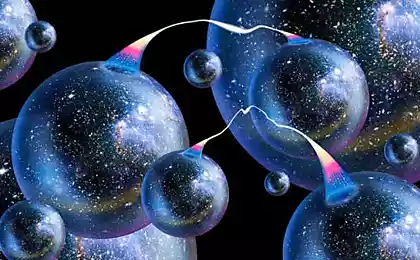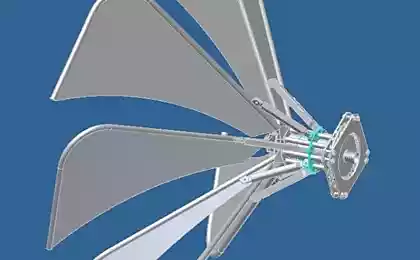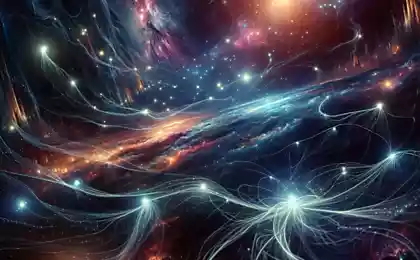668
As the space can move faster than the speed of light
Forty seven million one hundred sixty seven thousand seven hundred seventy five
Cosmologists in the shower time travelers. Looking back over billions of years, these scientists are able to trace the evolution of our Universe in amazing detail. 13.8 billion years ago there was a Big Bang. Within a fraction of a second the universe expanded exponentially for a short period of time called inflation. During the subsequent epochs of the cosmos grew to enormous sizes, we don't even see its edges.
But how can it be possible? If the speed of light signifies a cosmic speed limit, as there may be regions of space-time, photons which are out of our reach? And if they exist, how do we know about their existence? This question was answered by Vanessa Janek with UniverseToday.
Expanding universe As everything else in physics, our universe strives to exist in the lowest energy state possible. But after 10^-36 seconds after the Big Bang, as inflationary cosmologists believe that the cosmos was in a state of false vacuum energy is the lowest point, which actually was not the lowest. In search of the true Nadir of vacuum energy, after a fraction of a second, the universe inflated with a factor of 1050.
Since the universe continues to expand but at a slower speed. We see evidence of this expansion in the light of distant objects. As the photons released by the star or galaxy propagate across the Universe, the stretching of space causes them to lose energy. When photons reach us, their wavelength show redshift in accordance with the distance that they went through.
That's why cosmologists speak of the red shift as functions of the distance in space and time. Light from distant objects travels for so long that when we finally do see him, we see objects as they were billions of years ago.
The volume of the Hubble Red shift light allows us to see objects like galaxies as they existed in the distant past, but we cannot observe all the events that occurred in our Universe during its history. As our space expands, the light of some objects is simply too far away to notice him.
The physics of this boundary is based, in particular, on a piece of the surrounding space-time is called the Hubble volume. Here on Earth, we define the Hubble volume by measuring the so-called Hubble parameter (H0), a quantity which relates the speed of recession of distant objects with their redshift. It was first calculated by Edwin Hubble in 1929, revealing that the distant galaxy is receding from us at a speed proportional to the red shift of their light.

Two sources of redshift: Doppler and cosmological expansion. Bottom: detectors catch the light, emitted by the Central star. This light is stretched, or shifted, along with the expansion of space
Dividing the speed of light by H0, we get the Hubble volume. This spherical bubble encloses an area in which all objects are deleted from the Central observer at a speed less than the speed of light. Correspondingly, all objects outside the Hubble volume is removed from the center faster than the speed of light.
Yes, "faster than light". How is that possible?
The magic of relativity the Answer to this question is related to the difference between the special theory of relativity and General theory of relativity. Special relativity requires the so-called "inertial reference system", or, more simply, background. According to this theory, the speed of light is the same in all inertial systems. If the observer is sitting on a bench in the Park of the planet Earth, or take off from Neptune at breakneck speed, for it is the speed of light is always the same. A photon always moves away from the observer with a speed of 300 000 000 metres per second.
General relativity, however, describes the fabric of space-time. In this theory inertial frames of reference no. Space is not expanding relative to anything outside it, therefore, the limit of the speed of light relative to the observer is not running. Yes, galaxies outside the Hubble sphere is receding from us faster than the speed of light. But galaxies themselves are not overcome space limitations. For an observer in one of these galaxies, nothing violates special relativity. This space between us and these galaxies are accelerated and stretched exponentially.
Observable universe we have a little surprise: the volume of the Hubble — it is not the same that observable universe.
To understand this, consider that when the universe gets older, the remote takes light more time to reach our detectors here on Earth. We can see objects that are accelerated beyond our current Hubble volume, because the light we see today was released by them when they were inside the sphere.
Strictly speaking, our observable universe coincides with something called the particle horizon. The particle horizon marks the distance to the furthest light that we can observe in this moment of time, the photons had enough time to either remain within, or to catch up with the gently expanding sphere of Hubble.

The Observed Universe. Technically known as the particle horizon
What's with the distance? Just over 46 billion light years in any direction — and our observable universe diameter is about 93 billion light years, or more than 500 billion trillion miles.
(Small tip: the horizon of the particles is not the same as the cosmological event horizon. The particle horizon encompasses all events in the past that we can see at present. The cosmological event horizon, on the other hand, determines the distance at which future observer will be able to see at the time of the ancient light, which is emitted by our small area of space-time today.
In other words, the particle horizon deals with the distance to objects in the past, the ancient light that we can see today; the cosmological event horizon deals with the distance that can pass our modern light, as the far corners of the Universe are accelerating away from us).
Dark energy Through the expansion of the Universe, there are regions of the cosmos that we will never see, even if we wait an infinite time, until their light reached us. But what about those areas that lie just outside of our current Hubble volume? If this sphere is also expanding, will we see these border objects?
It depends on which region is expanding faster — the Hubble volume or the parts of the Universe close him outside. The answer to this question depends on two things: 1) increases or decreases H0; 2) accelerating or decelerating universe. These two rate are closely linked but are not one and the same.
In fact, cosmologists believe we live in a time when H0 is reduced; but because of dark energy the expansion rate of the Universe is increasing.
It may seem counterintuitive, but while H0 decreases at a slower rate than the expansion rate of the Universe, the General movement of galaxies away from us is still accelerating. And this time, according to cosmologists, the Universe's expansion will outpace the more modest growth of the Hubble.
So even though Hubble volume is expanding, the influence of dark energy sets a hard limit on the expansion of the observable Universe.
Cosmologists scratching their heads over deep questions like how it will look observable universe one day and how to change the extension of space. But in the end scientists can only guess answers to questions about the future, based on a current understanding of the Universe. Cosmological time frame is so unimaginably large that it is impossible to say anything concrete about the behavior of the Universe in the future. Modern models surprisingly well correspond to the modern data, but the truth is that none of us will live long enough to see, do predictions come true.published
Source: hi-news.ru
Cosmologists in the shower time travelers. Looking back over billions of years, these scientists are able to trace the evolution of our Universe in amazing detail. 13.8 billion years ago there was a Big Bang. Within a fraction of a second the universe expanded exponentially for a short period of time called inflation. During the subsequent epochs of the cosmos grew to enormous sizes, we don't even see its edges.
But how can it be possible? If the speed of light signifies a cosmic speed limit, as there may be regions of space-time, photons which are out of our reach? And if they exist, how do we know about their existence? This question was answered by Vanessa Janek with UniverseToday.
Expanding universe As everything else in physics, our universe strives to exist in the lowest energy state possible. But after 10^-36 seconds after the Big Bang, as inflationary cosmologists believe that the cosmos was in a state of false vacuum energy is the lowest point, which actually was not the lowest. In search of the true Nadir of vacuum energy, after a fraction of a second, the universe inflated with a factor of 1050.
Since the universe continues to expand but at a slower speed. We see evidence of this expansion in the light of distant objects. As the photons released by the star or galaxy propagate across the Universe, the stretching of space causes them to lose energy. When photons reach us, their wavelength show redshift in accordance with the distance that they went through.
That's why cosmologists speak of the red shift as functions of the distance in space and time. Light from distant objects travels for so long that when we finally do see him, we see objects as they were billions of years ago.
The volume of the Hubble Red shift light allows us to see objects like galaxies as they existed in the distant past, but we cannot observe all the events that occurred in our Universe during its history. As our space expands, the light of some objects is simply too far away to notice him.
The physics of this boundary is based, in particular, on a piece of the surrounding space-time is called the Hubble volume. Here on Earth, we define the Hubble volume by measuring the so-called Hubble parameter (H0), a quantity which relates the speed of recession of distant objects with their redshift. It was first calculated by Edwin Hubble in 1929, revealing that the distant galaxy is receding from us at a speed proportional to the red shift of their light.

Two sources of redshift: Doppler and cosmological expansion. Bottom: detectors catch the light, emitted by the Central star. This light is stretched, or shifted, along with the expansion of space
Dividing the speed of light by H0, we get the Hubble volume. This spherical bubble encloses an area in which all objects are deleted from the Central observer at a speed less than the speed of light. Correspondingly, all objects outside the Hubble volume is removed from the center faster than the speed of light.
Yes, "faster than light". How is that possible?
The magic of relativity the Answer to this question is related to the difference between the special theory of relativity and General theory of relativity. Special relativity requires the so-called "inertial reference system", or, more simply, background. According to this theory, the speed of light is the same in all inertial systems. If the observer is sitting on a bench in the Park of the planet Earth, or take off from Neptune at breakneck speed, for it is the speed of light is always the same. A photon always moves away from the observer with a speed of 300 000 000 metres per second.
General relativity, however, describes the fabric of space-time. In this theory inertial frames of reference no. Space is not expanding relative to anything outside it, therefore, the limit of the speed of light relative to the observer is not running. Yes, galaxies outside the Hubble sphere is receding from us faster than the speed of light. But galaxies themselves are not overcome space limitations. For an observer in one of these galaxies, nothing violates special relativity. This space between us and these galaxies are accelerated and stretched exponentially.
Observable universe we have a little surprise: the volume of the Hubble — it is not the same that observable universe.
To understand this, consider that when the universe gets older, the remote takes light more time to reach our detectors here on Earth. We can see objects that are accelerated beyond our current Hubble volume, because the light we see today was released by them when they were inside the sphere.
Strictly speaking, our observable universe coincides with something called the particle horizon. The particle horizon marks the distance to the furthest light that we can observe in this moment of time, the photons had enough time to either remain within, or to catch up with the gently expanding sphere of Hubble.

The Observed Universe. Technically known as the particle horizon
What's with the distance? Just over 46 billion light years in any direction — and our observable universe diameter is about 93 billion light years, or more than 500 billion trillion miles.
(Small tip: the horizon of the particles is not the same as the cosmological event horizon. The particle horizon encompasses all events in the past that we can see at present. The cosmological event horizon, on the other hand, determines the distance at which future observer will be able to see at the time of the ancient light, which is emitted by our small area of space-time today.
In other words, the particle horizon deals with the distance to objects in the past, the ancient light that we can see today; the cosmological event horizon deals with the distance that can pass our modern light, as the far corners of the Universe are accelerating away from us).
Dark energy Through the expansion of the Universe, there are regions of the cosmos that we will never see, even if we wait an infinite time, until their light reached us. But what about those areas that lie just outside of our current Hubble volume? If this sphere is also expanding, will we see these border objects?
It depends on which region is expanding faster — the Hubble volume or the parts of the Universe close him outside. The answer to this question depends on two things: 1) increases or decreases H0; 2) accelerating or decelerating universe. These two rate are closely linked but are not one and the same.
In fact, cosmologists believe we live in a time when H0 is reduced; but because of dark energy the expansion rate of the Universe is increasing.
It may seem counterintuitive, but while H0 decreases at a slower rate than the expansion rate of the Universe, the General movement of galaxies away from us is still accelerating. And this time, according to cosmologists, the Universe's expansion will outpace the more modest growth of the Hubble.
So even though Hubble volume is expanding, the influence of dark energy sets a hard limit on the expansion of the observable Universe.
Cosmologists scratching their heads over deep questions like how it will look observable universe one day and how to change the extension of space. But in the end scientists can only guess answers to questions about the future, based on a current understanding of the Universe. Cosmological time frame is so unimaginably large that it is impossible to say anything concrete about the behavior of the Universe in the future. Modern models surprisingly well correspond to the modern data, but the truth is that none of us will live long enough to see, do predictions come true.published
Source: hi-news.ru























